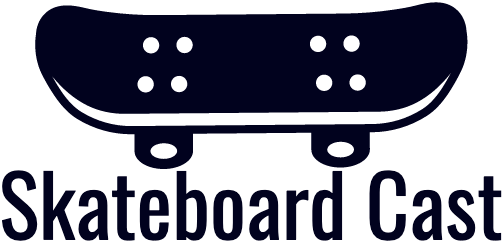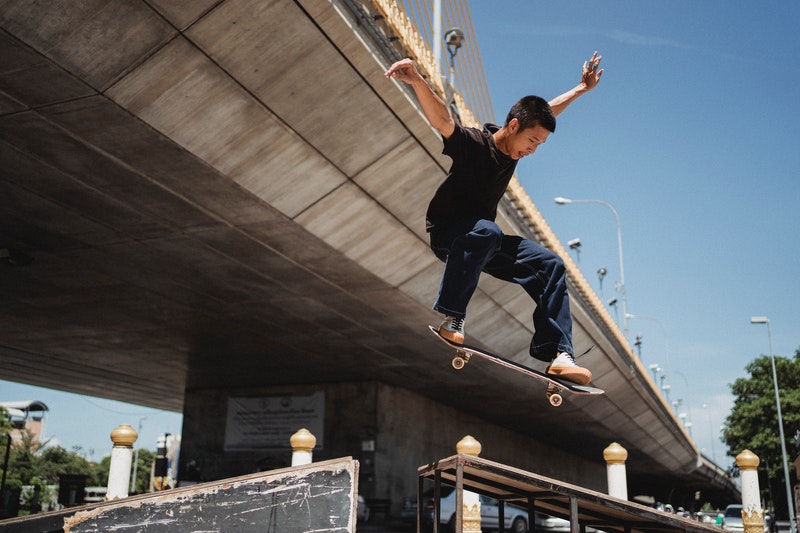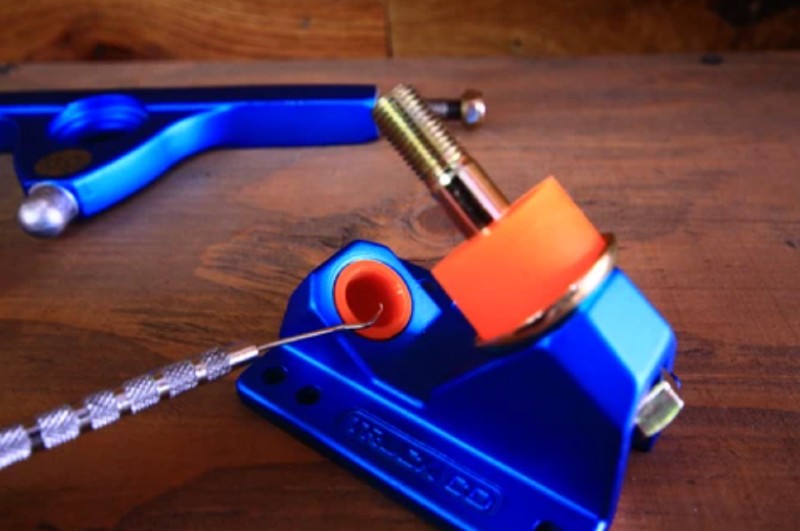Introduce
Skateboarding always comes up with challenges and requires many skills. Jumping onto a skateboard is one of them. You may find it hard at first. But, the skills are on the wheels. Keep on practicing with some tips we share below. Who knows, one day you may become professional.
And now, let’s read on and learn how do you jump on a skateboard!
How To Jump Onto A Skateboard?
One of the essential skating tricks is the skateboard jump. We often call it “Olli”. If the skateboarder does the trick perfectly, he may leap into the air while carrying the deck. The board appears to be linked to his feet.
Jump onto a skateboard
Jumping onto the skateboard is the foundation for many other skating tricks. Hence, mastering it is essential if you want to try other, more difficult techniques.
To jump onto a skateboard, do the following simple steps:
- 1: Lay your feet
- 2: Bend your knees
- 3: Raise the tail;
- 4: Jump up
- 5: Snatch the front foot
- 6: Align your shoulders and feet
- 7: Land
Now, let’s discuss each step properly.
Step 1: Lay Your Feet
Let’s begin with your front foot. Lay your foot in the center of the decks. Place your rear foot on your skateboard’s tail.
The rear foot’s heel is off the skateboard’s surface. Remember to keep both feet pointed straight forward. Make sure your legs are not at an angle.
How to lay your feet on
Step 2: Bend Your Knees
You need to bend your knees. Make sure your feet are not getting stuck. It is, in fact, the initial step towards raising the tail.
Step 3: Raise The Tail
With your rear foot, quickly and powerfully press down on the tail of your skateboard.
When you apply downward effort to the tail, it will contact the ground, creating a strong upward motion as the board starts popping up. Consider it a light-footed slide of your ankle downwards.
If you press too fast and hard on the tail, the board will not move up in the air because your body weight will block it.
Step 4: Jump Up
Jump up as soon as you raise the tail. Ensure that your legs are straight. There will be a crash between your feet and the deck if you cannot accomplish it. As you can see, this is a critical stage in the process.
Raise the tail
Step 5: Snatch The Front Foot
Snatch your front foot and the board up smoothly when leaping. Not attempt to exert pressure. Move the foot to the side. Stop when you get to the end of the board. Don’t step over the line.
Step 6: Align Your Shoulders And Feet
When you hit the tallest point, put your feet below you. Make sure your feet and shoulders are aligned. Lift your knees slightly and stretch your hands wider.
Step 7: Land
Landing is crucial. If you miss this step, you risk injuring your knee. Knees should be extended toward the ground. Continue to bend your knees slightly and absorb the impact of landing. Be sure that you maintain control of the skateboard.
Tips For A Master Jump
All the steps above may help you get familiar with the skateboard jump. To master it, you should learn more. We recommend some tips below:
- Give more attention to step 3 than the others. You’ll be able to get a flawless leap if you can pop up higher.
- Attempt to snatch late. You’ll be able to jump higher if you can accomplish it. Don’t attempt it at first.
- To do this skateboard trick, choose a safe location.
- Master the placement of your feet and the alignment of your body. It will assist you in making a professional leap.
FAQs
How do you jump and drop a skateboard?
Why can’t I ollie high?
Ollies are one of the most basic tricks in skateboarding, but mastering them can be challenging. Here are a few reasons why you might be struggling to ollie high:
Lack of Technique
To ollie high, you need to have proper technique. This includes timing, body positioning, and weight distribution. If your technique is off, it can limit your ability to generate power and height in your ollies.
Insufficient Pop
The “pop” is the motion of snapping the tail of the skateboard against the ground to generate upward force. If you’re not popping the board with enough force, it will limit how high you can ollie.
Weak Leg Muscles
Jumping requires strength in your leg muscles, particularly in your quads and calves. If these muscles are weak or underdeveloped, it can hinder your ability to generate power and jump higher.
Fear of Falling
Fear can also play a significant role in limiting your ollie height. If you’re hesitant or afraid of falling, you may hold back and not commit fully to the trick, resulting in lower jumps.
Can you ollie as high as you can jump?
Yes, you can ollie as high as you can jump. The ollie technique essentially mimics the motion of jumping off the ground while keeping both feet on the skateboard. By using the same jumping technique and applying it to your ollies, you can achieve similar heights.
Why can’t I drop in on a skateboard?
Dropping in on a skateboard can be intimidating for beginners. Here are a few reasons why you might struggle with dropping in:
Fear of Falling
Fear is often the biggest hurdle when it comes to dropping in on a skateboard. The fear of losing balance or crashing can make it difficult to commit to the motion.
Lack of Confidence
Confidence plays a crucial role when dropping in. If you doubt your abilities or hesitate during the process, it can throw off your balance and make it challenging to execute the drop-in properly.
Improper Technique
Dropping in requires a specific technique involving weight distribution, body positioning, and timing. If your technique is incorrect or inconsistent, it can make dropping in more challenging.
What is a skateboard jump called?
In skateboarding, a jump performed while riding on your skateboard is commonly referred to as an “ollie.” The ollie is a fundamental trick that allows skaters to jump over obstacles or perform more advanced tricks.
How should a beginner drop in on a skateboard?
Dropping in on a skateboard as a beginner can be intimidating, but with proper technique and practice, it becomes more manageable. Follow these steps to learn how to drop in:
- Find a suitable ramp or skatepark with a gradual incline.
- Position yourself at the top of the ramp with your front foot placed just behind the bolts and your back foot on the tail.
- Bend your knees and lean slightly forward to shift your weight towards the front foot.
- Gently push off with your back foot to start rolling down the ramp.
- As you approach the transition or flat bottom of the ramp, shift your weight back towards your heels and lift the front wheels slightly off the ground.
- Keep your body centered over the skateboard as you roll down.
- As you reach the bottom of the ramp, absorb the impact by bending your knees and maintaining balance.
- Practice dropping in on smaller ramps first before progressing to larger ones.
Should I jump when I ollie?
Yes, jumping is an essential component of the ollie technique. To perform an ollie, you need to pop the tail of your skateboard against the ground while simultaneously jumping with both feet. Jumping helps generate upward force and allows you to clear obstacles or perform tricks.
How to do easy skateboard tricks?
If you’re a beginner looking to learn some easy skateboard tricks, here are a few suggestions:
Manual
A manual is a trick where you balance on only two wheels of your skateboard while rolling. Start by shifting your weight towards the back wheels and practice maintaining balance.
Kickturn
A kickturn involves pivoting on the tail or nose of your skateboard while rolling. Start by placing your weight on the back foot and using your front foot to lift the nose slightly off the ground. Pivot 180 degrees and return to your original position.
Boneless
A boneless is a trick where you grab the board with one hand while jumping off your back foot. Start by grabbing the board near the front bolts, then jump off your back foot while pulling the board up towards you.
No-Comply
A no-comply is a trick where you lift one foot off the skateboard while using the other foot to kick off the ground. Practice lifting one foot off the board and using your other foot to kick off the ground for momentum.
Do I jump when I ollie?
Yes, jumping is an integral part of executing an ollie. To perform an ollie, you need to generate upward force by popping the tail against the ground while simultaneously jumping with both feet. The jumping motion helps elevate both yourself and the skateboard off the ground.
How do I learn to drop in?
Learning to drop in on a skateboard takes practice and patience. Here are some steps to help you learn how to drop in:
- Find a suitable ramp or skatepark with a low incline.
- Position yourself at the top of the ramp with your front foot placed just behind the bolts and your back foot on the tail.
- Bend your knees and lean slightly forward to shift your weight towards the front foot.
- Gently push off with your back foot to start rolling down the ramp.
- As you approach the transition or flat bottom of the ramp, shift your weight back towards your heels and lift the front wheels slightly off the ground.
- Keep your body centered over the skateboard as you roll down.
- Practice dropping in on smaller ramps first before progressing to larger ones.
- Gradually increase speed and confidence as you become more comfortable with dropping in.
How do you fall off a skateboard safely?
Falling off a skateboard is inevitable, especially when attempting new tricks or maneuvers. Here are some tips for falling safely:
- Stay Relaxed: Try to stay calm and relaxed during a fall as tensing up can lead to more severe injuries.
- Roll with It: If possible, try to roll with the fall rather than resisting it. Rolling can help distribute impact forces more evenly.
- Protect Your Head: Always wear a helmet to protect your head from injury during falls.
- Use Protective Gear: Consider wearing knee pads, elbow pads, and wrist guards to protect vulnerable joints.
- Learn How to Fall: Practice falling techniques such as tucking and rolling or sliding out on impact.
- Fall Away from Your Board: Try to fall away from your skateboard to avoid potential injuries caused by colliding with it.
What is a rock-to-fakie?
A rock-to-fakie is a trick where you ride up a ramp or transition, pivot on the tail or nose of your skateboard at the peak of your movement, and ride back down backward (fakie) instead of continuing forward.
How easy is an ollie?
An ollie is considered one of the foundational tricks in skateboarding but can be challenging for beginners. It requires practice and consistency to develop proper technique and timing. With dedication and persistence, mastering an ollie becomes easier over time.
Can anyone train to jump high?
Yes, anyone can train to jump higher with proper training techniques and consistent practice. Jumping ability can be improved through strength training exercises that target leg muscles, plyometric exercises that focus on explosive power, and practicing jumping techniques specific to skateboarding.
How much height can a person jump?
The height a person can jump depends on various factors such as their strength, explosive power, technique, and training level. On average, an untrained individual can typically jump anywhere between 12-24 inches off the ground. However, with proper training and conditioning, individuals can significantly improve their jumping height and achieve greater airtime on their skateboard.
| See more: |
Conclusion
We have shared with you some tips about how do you jump on a skateboard. Hopefully, it was able to give you helpful information that you can put into practice effectively.
Keep in mind that the technique necessitates progressing from a simple to a complex level. It would be best if you also put in a lot of effort every day. Best of luck!



